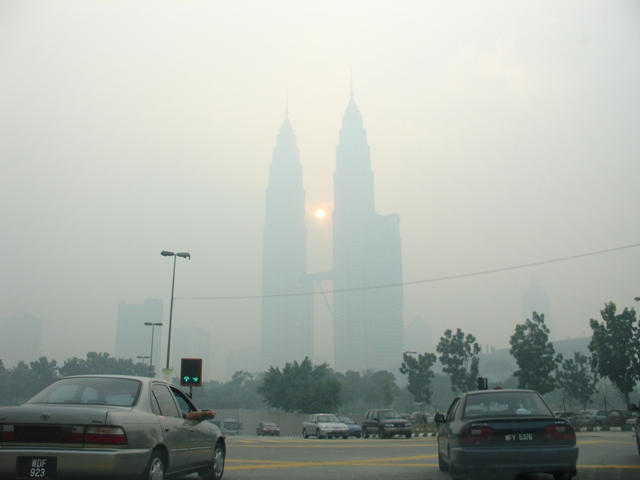
Often times in the morning, I’ll get out of bed and peer out from behind my thick curtains to check the weather, or more specifically these days, the haze. It’s a telling thing when I look out to relatively clear conditions and think, “Oh good, it’s not hazy today!” That mindset indicates to me that, somewhere along the line, at least a degree of haziness has become the rule rather than the exception.
I moved to KL in 2008, just over a decade after what is widely considered the worst summer of haze to plague the Peninsula, the region-wide smothering of 1997. The haze was so serious in June and July of that year, emergency measures were put into place, schools were closed throughout Malaysia, and the fallout from the polluted skies cost an estimated US$4.5 billion in Malaysia, Indonesia, Singapore, and southern Thailand, including increased healthcare costs, lost productivity, disruptions to air travel, and unsurprisingly, a decline in tourism. The Air Pollution Index, which at a level of 300 is considered hazardous, peaked at a shocking 839 in parts of Sarawak that year. The severity of the haze resulted in ASEAN meetings convened to address the issue, but Jakarta refused to sign the trans-boundary agreement when it was drafted in 2002, and perhaps in tandem with that reluctance, the problem continued. Serious levels of haze have become an almost annual occurrence, with hazardous levels recorded in 2005, 2006, 2009, and 2013. Last year’s haze was in fact the worst since 1997 (API readings spiked at 746 in Johor), so it seems the meetings and talks have not resulted in much action.
Predictably, blaming Indonesia for the problem is common practice in Malaysia whenever haze settles across the Peninsula, and to be fair, most of the smouldering fires that create the haze – often in deep peat bogs which fuel fires that are extremely difficult to extinguish – are indeed in Indonesia. But though most of the haze episodes can be traced to slash-and-burn fires in Sumatra, a significant percentage takes place on land owned by Malaysian companies, and in fact the same practice is carried out in Malaysia, too, both on the Peninsula and in Borneo, leaving Malaysia without much of a leg to stand on when it tries to criticise Indonesia for not prosecuting open burning. It’s a significant challenge in any case for Malaysia to stand up to the region’s indisputable giant and make demands, but that challenge is compounded mightily when Malaysia is guilty of the same behaviour it’s trying to make Indonesia curtail.
Further complicating the ongoing issue, Malaysia’s response has not, historically, always been impressive. During the 1997 crisis, then-PM Mahathir banned journalists from reporting on the haze, reportedly claiming there was a conspiracy to smear Malaysia’s image. In 2005, in the throes of another miserable haze outbreak, PM Badawi’s action plan was to “call on mosques to pray for rain.” Even now, Malaysia has been criticised by its ASEAN neighbours for a recent response that is, like the hazy air itself, far from transparent. According to the news, documents retrieved from regional meetings showed that Indonesia and Malaysia had signed an agreement to exchange geo-referenced maps that would pinpoint when and where the haze-generating fires had started, giving authorities evidence needed to take punitive action against companies who were clearing land and forests by burning. Yet the news report claims that officials in Jakarta and KL have “conspired to keep the information to themselves and their relevant ministries.” In two countries widely known to struggle with corruption, there are suspicions that officials may be keeping criminally damning evidence under wraps for personal gain courtesy of large companies seeking to avoid prosecution. There seems to be no direct proof of this, but such suspicions could be easily prevented by practicing openness and transparency.
This year, though the individual days of haziness may not have been as bad as previous years, it sure feels like there have been more of them overall. Starting around February this year, it seems there have been more hazy days than not, and dispiriting, ugly white-gray skies prevail in the Klang Valley on a regular basis. Aesthetics aside, hazy days have a genuine health impact on people and can drag down a city’s quality of life, both in perception and in reality. Persistent haze certainly creates or adds to the perception of KL being polluted, a view that not only keeps tourists away, but can influence expats’ decisions on moving. Indeed, overseas companies seeking a hub in Asia for their business could possibly omit KL from consideration if they visit and see such persistent haze. As one expat who wrote to us said, “For Malaysia’s future as an expat and MM2H destination, the question of air quality and environment is going to be increasingly important, and KL will never make it into the world’s top cities to live in without proper management of air quality.” So it begs the question: what is Malaysia doing about it? For the health of their people, for the strength of their economy, and for achieving the stated goals of making KL one of the world’s most liveable cities, Malaysia must tackle – and solve – the recurring and increasingly persistent haze issue.
Homepage Highlight Photo credit: ToGa Wanderings / Foter / CC BY-NC-ND
Source: The Expat Magazine September 2014
Read more:
- Expat Musings: Perspective, Success and Accomplishment
- 5 Things You Should Know About Driving in Malaysia
- The Cost of Living in Kuala Lumpur
What are your thoughts on this article? Let us know by commenting below. No registration needed.
"ExpatGo welcomes and encourages comments, input, and divergent opinions. However, we kindly request that you use suitable language in your comments, and refrain from any sort of personal attack, hate speech, or disparaging rhetoric. Comments not in line with this are subject to removal from the site. "


















